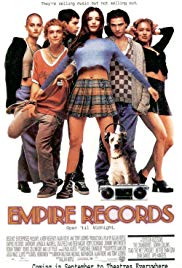Empire Records as a Reward Film:
Before the film is shown to students tell them that the ways in which the characters in this film treat each other is interesting. Students who object to seeing anything with a level above Dumb and Dumber or the latest action extravaganza may need to be reminded that, after all, they are in school and even reward films have an educational purpose. See TWM’s article on Reward Films.
Consider engaging the class in the following discussions after the after students have watched the film.
1. Which character is most at risk for trouble in the future? Describe how this character is at risk and identify any events in the film that would indicate that their problems.
Suggested Response:
There is no one correct response. There are several strong responses. (1) Corey was well on her way to a serious drug problem. What was she going to do when she got into the hyper-competitive environment at Harvard when she had to compete with other smart students? She’d turn to speed again. There is nothing to indicate that Corey recognizes the risk to her from the speed that she is taking. (2) Gina’s self-esteem issues were major and she didn’t have the self-assurance to try to do what she wanted to do. Just because she was singing at the impromptu party to raise money to pay Lucas’ debt doesn’t mean that she could find a band to sing with or that she would even look hard. On the other hand, a reasonable argument could be made that singing in front of the crowd would give Gina the confidence she needed to go change her life. (3) Debra is another candidate because one good night doesn’t resolve problems that took years to develop. When the party was over Debra would still have the problems that drove her to attempt suicide in the first place. However, perhaps the day shown in the movie — when Joe praised her work, when she was able to successful counsel Corey, when her friends demonstrated how much they cared for her by giving her the mock funeral, and when she was part of making the party happen to raise the money to help Lucas and Joe — might be a turning point for Debra. (4) “Warren”, the shoplifter, is obviously a troubled youth and a poster-child for those with poor judgment. While he could mature under Joe’s tutelage in the new record store, anyone who’d waiving a gun around a public place threatening people is just not smart; and he got away with it, getting hired by the store! While at least he had the intelligence to put blanks in the gun, “Warren” could very well have been shot dead by a policeman, a store employee, or, in certain states, a customer carrying a concealed weapon.
2. Why didn’t Joe turn Lucas into the police? After all, Lucas had stolen and then gambled away $9000, dooming Joe’s chance to buy into the record store.
Suggested Response:
Joe who had gotten Lucas out of foster care and had raised him. Lucas was like a son to him.
3. From the beginning through the first 2/3rds of the film, there was a lot of pent up and sometimes expressed anger among Corey, Gina, and Debra. How did they overcome it?
Suggested Response:
By being able to recognize what was important to them; by treating each other as human beings; by forgiving and not holding grudges.
4. What does this movie tell us about friendship?
Suggested Response:
There is no one correct answer. Good responses will include concepts such as being willing to forgive and being willing to look out for the other person.
Using Empire Records to Drive Writing Assignments in an ELA Class
Each of the discussion questions can serve as a writing prompt. For additional discussion questions, see Discussion Questions for Use With any Film that is a Work of Fiction.



